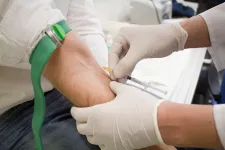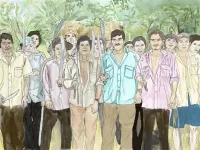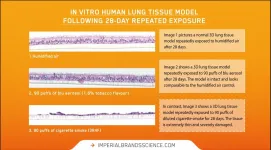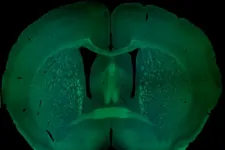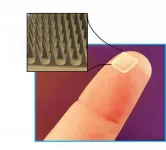Release of drugs from a supramolecular cage
Hot paper in Angewandte Chemie
2021-05-05
(Press-News.org) How can a highly effective drug be transported to the precise location in the body where it is needed? In the journal Angewandte Chemie, chemists at Heinrich Heine University Düsseldorf (HHU) together with colleagues in Aachen present a solution using a molecular cage that opens through ultrasonification.
Supramolecular chemistry involves the organization of molecules into larger, higher-order structures. When suitable building blocks are chosen, these systems 'self-assemble' from their individual components.
Certain supramolecular compounds are well suited for 'host-guest chemistry'. In such cases, a host structure encloses a guest molecule and can shield, protect and transport it away from its environment. This is a specialist field of Dr. Bernd M. Schmidt and his research group at the Institute of Organic and Macromolecular Chemistry at HHU.
The chemists in Düsseldorf collaborated with colleagues from the DWI Leibniz Institute for Interactive Materials to find a system that may one day even be able to transport cargo molecules through the human body and release the drug at the desired location.
The solution may be to use discrete 'Pd6(TPT)4 cages'. These are octahedral cage-like assemblies, bearing polymer chains on each vertex. They are comprised of four triangular panels, palladium atoms and connecting units.
When the individual components are added to an aqueous solution in the correct ratio, the cages self-assemble. If smaller, hydrophobic molecules are added to the cages, they enter the cavities. The researchers demonstrated this effect using pharmaceutically active molecules, like ibuprofen and progesterone.
"The special trick with our system involves the pre-determined rupture points", explains Dr. Schmidt, last author of the study. "The palladium atoms hold all compounds with a comparatively weak bond. Once you succeed in breaking the atoms out of the compound, the entire octohedral structure breaks apart."
To break the bonds, the researchers in Aachen use powerful ultrasonification similar to that used medically to break down kidney stones, for example. In water, the ultrasound creates cavitation bubbles that burst and exert huge mechanical shear force on the long polymer chains. The forces are so powerful that the palladium atoms are actually torn from the vertices and thus rupture the octahedral cage. The small drug molecules are agitated in the process but are not damaged.
Dr. Robert Göstl (DWI) says: "Localised ultrasound radiation of the tissue to be treated could mean that the drug transported in the cage is later released at the exact location where the therapy is needed." The drug molecules used in the study serve merely as examples. In principle, a large number of different hydrophobic molecules can be packed in the cage. Unlike other host-guest systems described, it is not necessary to alter the drug molecules chemically in order to get them in the cage. "To treat tumours, it would be feasible to use cytostatic drugs as the cargo, for example. By releasing them directly at the site of a solid tumour, it may be possible to have chemotherapy that uses much less of the drug and thus has lesser side effects", explains Schmidt.
This is helped by the fact that the defined cargo volume makes it possible to measure precisely how much of the drug is released at the target site. "The dose administered could even be calculated precisely."
The study is a Proof of Concept that demonstrated the feasibility of the approach. It also convinced the reviewers and publishers of the journal "Angewandte Chemie", who rated the publication as very important. The work, which is classified as "Hot Paper", will also be featured on the cover of the upcoming issue.
"The next steps involve determining how real cells respond to our cages. Before any medical use, we need to ensure that they are not toxic."
INFORMATION:
Original publication
Robin Küng, Tobias Pausch, Dustin Rasch, Robert Göstl and Bernd M. Schmidt, Mechanochemical Release of Non-Covalently Bound Guests from a Polymer-Decorated Supramolecular Cage, Angew. Chem. Int. Ed. (2021)
DOI: 10.1002/anie.202102383
[Attachments] See images for this press release:

ELSE PRESS RELEASES FROM THIS DATE:
2021-05-05
The United States-Mexico border traverses through large expanses of unspoiled land in North America, including a newly discovered worldwide hotspot of bee diversity. Concentrated in 16 km2 of protected Chihuahuan Desert are more than 470 bee species, a remarkable 14% of the known United States bee fauna.
This globally unmatched concentration of bee species is reported by Dr. Robert Minckley of the University of Rochester and William Radke of the United States Fish and Wildlife Service in the open-access, peer-reviewed Journal of Hymenoptera Research.
Scientists studying native U.S. bees have long recognized that the Sonoran and Chihuahuan deserts of North America, home to species with interesting life histories, have high bee biodiversity. Exactly how many species ...
2021-05-05
Sanaria® PfSPZ-CVac" is a live vaccine consisting of infectious Plasmodium falciparum (Pf) malaria parasites that are injected into the subject at the same time as they receive an antimalarial drug. The parasites quickly enter the liver where they develop and multiply for 6 days, and then emerge into the blood As soon as the parasites leave the liver, the drug kills them immediately. Thus, the immune system of the vaccinated subject is primed against many parasite proteins and becomes highly effective at killing malaria parasites in the liver to block infection and prevent disease.
"With this study, we have reached a new important milestone in the development of an effective malaria vaccine. With only three immunizations over four weeks, we achieved very good protection ...
2021-05-05
Daniel Redhead, from the Max Planck Institute for Evolutionary Anthropology, and Chris von Rueden, from the University of Richmond, published a new study that describes coalition formation among men in Tsimané Amerindians living in Amazonian Bolivia, over a period of eight years. In two Tsimané communities, the authors describe the inter-personal conflicts that tend to arise between men, and the individual attributes and existing relationships that predict the coalitional support men receive in the event of conflicts.
Conflicts that arise between men concern disputes over access to forest for slash-and-burn horticulture, as well as accusations of theft, laziness, negligence, ...
2021-05-05
In about a quarter of patients with hereditary diseases, the cause of the disease remains unclear even after extensive genetic testing. One reason is that we still do not know enough about the function of many genes. Of the 30,000 known genes, just a little more than 4,000 have been found to be associated with hereditary diseases.
At the Department of Clinical Genetics of the University of Tartu Institute of Clinical Medicine, under the leadership of Professor Katrin Õunap, patients with hereditary diseases of unclear cause have been studied in various research projects since 2016. In collaboration with the Broad Institute of MIT and Harvard, these patients have undergone extensive genome-wide sequencing analyses at the level of the exome (the sequence of all genes), ...
2021-05-05
Knowing what species live in which parts of the world is critical to many fields of study, such as conservation biology and environmental monitoring. This is also how we can identify present or potential invasive and non-native pest species. Furthermore, summarizing what species are known to inhabit a given area is essential for the discovery of new species that have not yet been known to science.
For less well-studied groups and regions, distributional species checklists are often not available. Therefore, a series of such checklists is being published in the open-access, peer-reviewed Journal of Hymenoptera Research, in order ...
2021-05-05
5 May 2021, Bristol - In one of the most advanced applications of in-vitro 3D human lung models in vape research to date, a new peer-reviewed Imperial Brands study shows that, unlike combustible cigarette smoke, blu aerosol had little to no impact on numerous toxicological endpoints under the conditions of test using laboratory models.
Published in the journal Current Research in Toxicology, the experiments compared the toxicological responses of an in vitro 3D lung model (MucilAir™ from Epithelix) after repeated exposure to undiluted whole blu aerosol (1.6% tobacco flavour) or diluted whole cigarette smoke (3R4F Kentucky Reference) over a 28-day period.
After repeatedly exposing the model to ...
2021-05-05
Announcing a new article publication for BIO Integration journal. In this editorial the authors Hui Liu and Juan Chen from Shanxi Eye Hospital, Taiyuan, China discuss biophotonics in photomedicine.
As a cross-disciplinary field, biophotonics is a natural platform for innovation, e.g. researchers have taken advantages of the recently developed nanostructures in Photomedicine to optimize imaging signals and improve drug delivery efficiency. Active investment in healthcare also contributes to the quick clinical transitions of biophotonic innovations.
However, to genuinely and successfully improve people's lives, many gaps have to be bridged. Horizontally, ...
2021-05-05
After reviewing a database of gene mutations in children with autism spectrum disorder (ASD), a team of Medical University of South Carolina (MUSC) researchers decided to study a specific gene mutation that likely caused ASD in a girl. They demonstrated that the mutation was damaging to the gene, and that female, but not male, mice lacking a working copy of the gene also showed ASD-associated symptoms. Better understanding the interplay between genetics and sex in ASD could set the stage for developing sex-specific treatments for autism.
The MUSC team was led by Christopher Cowan, Ph.D., the William E. Murray SmartState Endowed Chair in Neuroscience and chair of the Department of Neuroscience, and Ahlem Assali, Ph.D., research assistant ...
2021-05-05
A recent study from the University of Helsinki monitors the breakthrough progresses in the development of microneedles for immunotherapy and discusses the challenges regarding their production. Researchers suggest using microneedles for immunotherapy due to the high abundance of immune cells under the skin. The aim is to vaccinate or treat different diseases, such as cancer and autoimmune disorders, with minimal invasiveness and side effects.
"Our study addresses the recent achievements in the development of microneedles for immunotherapy of hard-to-treat and chronic diseases to achieve the highest efficiency with minimal side effects," says ...
2021-05-05
There is currently no consensus on what quality end-of-life care for children with cancer looks like, or how to measure and deliver it; however, investigators recently assembled an expert panel to help fill this void. In a study published early online in CANCER, a peer-reviewed journal of the American Cancer Society, the panel endorsed 16 measures that cover different aspects of care that are important for children with cancer and their families.
"Measuring the quality of the care delivered is an essential part of ensuring high quality end-of-life care ...
LAST 30 PRESS RELEASES:
[Press-News.org] Release of drugs from a supramolecular cage
Hot paper in Angewandte Chemie


